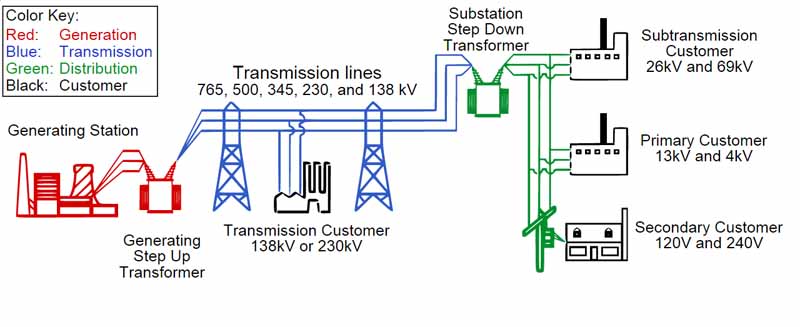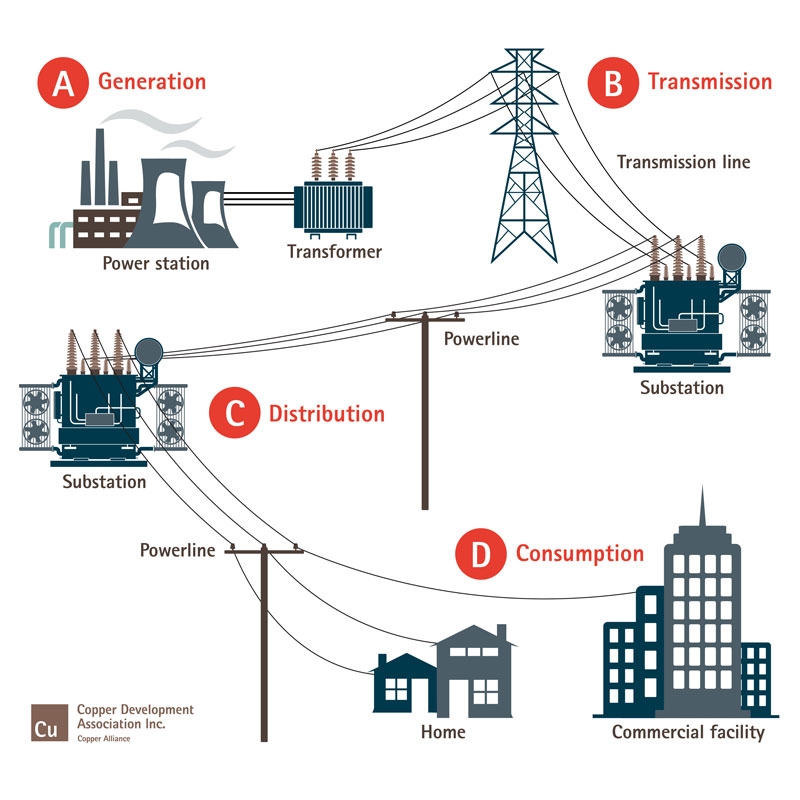What is grid system in electricity? The electrical grid system is the backbone of modern society, providing a reliable and efficient way to generate, transmit, and distribute electricity to homes, businesses, and industries. This intricate network of power plants, transmission lines, and substations ensures that we have access to the electricity we need to power our lives.
In this comprehensive guide, we will delve into the fascinating world of electrical grid systems, exploring their components, functions, benefits, challenges, and the exciting future that lies ahead.
Overview of Grid System in Electricity
An electrical grid system, also known as a power grid, is a network of interconnected components that transmits and distributes electricity from power plants to consumers.
The grid system consists of several components, including power plants, transmission lines, distribution lines, and substations. Power plants generate electricity, which is then transmitted through high-voltage transmission lines to substations. Substations reduce the voltage of the electricity and distribute it to consumers through distribution lines.
Types of Electrical Grid Systems
There are different types of electrical grid systems, including:
- Radial systems:In a radial system, power flows from a central power plant to consumers through a single path.
- Loop systems:In a loop system, power can flow in multiple directions through a network of interconnected lines.
- Grid systems:In a grid system, power can flow in multiple directions through a network of interconnected lines and substations.
Functions of a Grid System
A grid system in electricity is a network of interconnected components that work together to generate, transmit, and distribute electricity to consumers. It consists of power plants, transmission lines, substations, transformers, and distribution lines.
Generation
Electricity is generated at power plants, which convert various energy sources (such as fossil fuels, nuclear power, or renewable energy sources like solar and wind) into electrical energy. The generated electricity is then stepped up to higher voltage levels using transformers to reduce power loss during transmission.
Transmission
The high-voltage electricity is transmitted over long distances through transmission lines, which are typically overhead lines supported by towers or underground cables. Transmission lines are designed to minimize power loss and maintain voltage stability.
Distribution, What is grid system in electricity
Once the electricity reaches the local area, it is stepped down to lower voltage levels using transformers at substations. The electricity is then distributed to homes, businesses, and industries through distribution lines, which are typically overhead lines or underground cables.
Substations and Transformers
Substations are critical components of the grid system. They house transformers, which change the voltage of electricity to match the requirements of different parts of the grid. Substations also contain switchgear and other equipment to control the flow of electricity and protect the grid from faults.
Grid Stability and Reliability
Grid stability refers to the ability of the grid to maintain a constant frequency and voltage. Reliability refers to the ability of the grid to deliver electricity to consumers without interruptions. Maintaining grid stability and reliability is crucial for the safe and efficient operation of the electrical system.
Benefits of Grid Systems

Grid systems bring about significant advantages in the electricity sector, encompassing energy efficiency, economic viability, and reliability of electricity supply.
In terms of energy efficiency, grid systems facilitate the integration of renewable energy sources, such as solar and wind power, which have intermittent availability. By connecting these sources to the grid, excess electricity generated during periods of high production can be distributed to areas experiencing peak demand, reducing the need for fossil fuel-based generation and promoting sustainable energy practices.
Economic Benefits
Grid systems offer substantial economic benefits. They enable the efficient allocation of electricity resources, reducing the overall cost of electricity generation and transmission. By connecting different regions with varying electricity prices, grid systems allow for the transfer of electricity from areas with surplus generation to areas with high demand, resulting in cost savings for consumers.
Reliability of Electricity Supply
Grid systems play a crucial role in enhancing the reliability of electricity supply. They provide backup power sources in case of outages, ensuring a continuous flow of electricity to consumers. By interconnecting multiple power plants and transmission lines, grid systems create a resilient network that can withstand disruptions and maintain stable electricity supply even during peak demand or emergencies.
Challenges of Grid Systems

Integrating renewable energy sources, managing grid congestion, and mitigating cyber threats are among the key challenges facing grid systems today.
The intermittent nature of renewable energy sources like solar and wind can create challenges for grid operators, as they need to ensure a reliable and stable supply of electricity. Grid congestion occurs when there is too much electricity flowing through a particular part of the grid, which can lead to power outages or damage to equipment.
Cyber threats can also pose a significant risk to grid security, as they could be used to disrupt or even shut down the grid.
Integrating Renewable Energy Sources
The integration of renewable energy sources into the grid is essential for reducing our reliance on fossil fuels and mitigating climate change. However, the intermittent nature of these sources can create challenges for grid operators.
- Solar and wind power generation can vary significantly depending on the weather conditions.
- This variability can make it difficult to predict how much electricity will be available from these sources at any given time.
- Grid operators need to be able to balance the supply of electricity from renewable sources with the demand from consumers.
Grid Congestion
Grid congestion occurs when there is too much electricity flowing through a particular part of the grid. This can be caused by a number of factors, including:
- Increased demand for electricity
- The flow of electricity from renewable energy sources
- The outage of a transmission line
Grid congestion can lead to power outages or damage to equipment. Grid operators need to be able to manage congestion in order to ensure the reliable and safe operation of the grid.
Cyber Threats
Cyber threats pose a significant risk to grid security. These threats could be used to disrupt or even shut down the grid.
- Cyber attacks could target the grid’s control systems, communications networks, or power plants.
- These attacks could cause power outages, damage to equipment, or even loss of life.
- Grid operators need to be able to protect the grid from cyber threats in order to ensure the reliable and safe operation of the grid.
Future of Grid Systems: What Is Grid System In Electricity

The future of grid systems is shaped by emerging technologies and advancements that aim to enhance efficiency, reliability, and sustainability. These technologies include distributed energy resources, smart grids, and advanced control systems.
Role of Distributed Energy Resources
Distributed energy resources (DERs), such as solar panels, wind turbines, and microgrids, are increasingly being integrated into the grid. DERs provide local generation and storage, reducing reliance on centralized power plants and improving grid resilience.
Smart Grids
Smart grids leverage advanced technologies to monitor, control, and optimize the grid. They use sensors, communication networks, and advanced analytics to improve efficiency, reliability, and demand response. Smart grids enable real-time monitoring of grid conditions, allowing for proactive maintenance and load balancing.
Advanced Control Systems
Advanced control systems are being implemented to optimize grid operations. These systems use artificial intelligence and machine learning to predict demand, optimize generation, and manage grid assets. Advanced control systems enhance grid stability and reduce energy losses.
Last Word
As we look towards the future, the electrical grid system is undergoing a remarkable transformation. The integration of renewable energy sources, the rise of distributed energy resources, and the advancement of smart grid technologies are shaping a new era of electricity delivery that promises to be more efficient, reliable, and sustainable than ever before.
The electrical grid system is a testament to human ingenuity and innovation. It is a complex and dynamic system that plays a vital role in our daily lives. As we continue to explore and develop new technologies, the future of the electrical grid system is filled with endless possibilities.
Detailed FAQs
What are the main components of an electrical grid system?
The main components of an electrical grid system include power plants, transmission lines, substations, transformers, and distribution lines.
How does electricity flow through the grid system?
Electricity is generated at power plants and then transmitted through high-voltage transmission lines to substations. At substations, the voltage is reduced and the electricity is distributed to homes, businesses, and industries through distribution lines.
What are the benefits of using a grid system?
Grid systems provide a number of benefits, including improved energy efficiency, reduced costs, and increased reliability.
